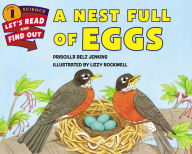Describes the parental behavior of Emperor penguins, focusing on how the male keeps the egg warm until it hatches and how the parents care for the chick after it is born.
Publishers Weekly
"The lively text and naturalistic acrylics of the frozen environment will attract many readers to this tale of one of nature's unique parenting arrangements, the emperor penguin," PW said. Ages 5-8. (Sept.) Copyright 2002 Cahners Business Information.
Publishers Weekly - Publisher's Weekly
After Chapman (One Duck Stuck) lures readers with an irresistible cover image of a baby emperor penguin, the author documents the unusual role of the father in the birthing of this winning subject. Emperor penguins make their home in Antarctica, "the coldest, windiest place on Earth." During the region's chilliest season, a female penguin lays one egg and leaves her mate to incubate it; he rests the egg atop his feet, so that his feathery white belly keeps it toasty. "What's more, there's nothing for the father penguin to eat on land.... So that means two whole months with an egg on your feet and no dinner!" Chapman provides naturalistic acrylics of the frozen environment, against cold violet or warm orange backdrops. The blue-white ice and sky offset the charcoal feathers and buttercup-yellow breasts of the birds. Jenkins presents abundant penguin facts in the same conversational voice of Chameleons Are Cool but without the child narrator he used to such strong effect. Yet he achieves a similar tone, for instance, while speculating that the male penguin must be "very, very miserable" as it awaits the egg's hatching and the mother bird's return. Together with artwork that balances realistic details with the penguins' implicit charm, Jenkins's lively text will attract many readers to this tale of one of nature's unique parenting arrangements. Ages 5-8. (Oct.) Copyright 1999 Cahners Business Information.
Children's Literature - Peg Glisson
Charmingly told, this simple narrative nonfiction tells the story of the birth of a penguin chick. While focusing on Dad's role in keeping the egg warm and safe, information about the environment and habits of emperor penguins is woven into the tale. Chapman's mostly blue, gray, and white acrylic paintings show a cute little chick without anthropomorphizing. Her use of perspective and frames allow young readers to see details as well as the expanse of the Antarctic. Humorous asides in the text, directed at the reader, are effectively done by Marriott. His reading, coupled with sound effects, add to the sense of cold and loneliness. The CD in this "Read Listen & Wonder" entry includes a section with facts about wolves as well as two tracks of audio for the story, with or without prompts for page-turns. Children will be enthralled as they listen and learn from this beautiful book. Reviewer: Peg Glisson
Children's Literature
This introduction to the Emperor penguin of Antarctica furnishes factual information as we follow one father penguin's two-month stint on the ice, keeping his egg warm on his feet "tucked right up under" his tummy. In simple language, with humor and much empathy for the dad, the text rambles across the pages, using oversize type for emphasis, and telling an engrossing tale of endurance. In smaller italics, basic facts are added. The hatching of the chick and reappearance of the mother allow the hungry father to eat at last. It's about time, too! Chapman's naturalistic paintings zoom in on such details as the tucked-in egg, and sometimes expand to depict the vast blue-white nothingness of the landscape. The visual story is told with considerable clarity and enough variety to entice the reader to turn the page. The penguin on the jacket/cover is very appealing. An index is included.
Library Journal
Gr 1-3-Emperor penguin paternity is presented in a positive light in this genial picture book. After a female lays an egg in late autumn, her mate does his utmost to keep his offspring warm while she goes off to spend the winter feeding in the sea. He does not feed himself for two months-well after his hatchling arrives. After the chick hatches, the mother returns and both parents take turns looking after it. It is a true labor of love at the bottom of the world. The anthropomorphizing and Jenkins's repeated asides ("I don't know about you but I'd be VERY, VERY miserable" or "YUK, you may think. YUM, thinks the chick, and gobbles it all down") undermine the book's value as nonfiction. Type sizes change with the mood of the action. Factoids, written in small, italicized script, are interspersed throughout but do not interfere with the narrative flow. The endearing acrylic illustrations are largely naturalistic. Blue and purple backgrounds throughout convey a cold, even Antarctic, feel. Gail Gibbons's Penguins! (Holiday, 1998) covers much of the same material. Students who are wild about penguins and classrooms doing units on them will find The Emperor's Egg an action-packed read and an appealing choice to clue readers in on just how hard Emperor dads work. However, it isn't nonfiction in the true sense of the word.-Anne Chapman Callaghan, Racine Public Library, WI Copyright 1999 Cahners Business Information.
School Library Journal
K-Gr 3 Martin Jenkins's book (Candlewick, 1999) relates the story of how, after the female penguin lays her egg and goes back to the sea, the male Emperor penguin is responsible for keeping it warm and safe for two months until it hatches. Shortly after the chick arrives, the female returns to feed and care for the baby. The lively text and Jane Chapman's wonderful illustrations will enthrall youngsters. The CD features three tracks: a competently and pleasantly narrated version with sound effects, a read-along version with page-turn signals, and a segment that includes more details about Emperor penguins. This nature story offers abundant penguin facts and can supplement a polar region unit, be paired with The March of the Penguins film as well as other recently released books about penguins, and be enjoyed in a listening center.-Stephanie Farnlacher, Trace Crossings Elementary School, Hoover, AL
Read More

















